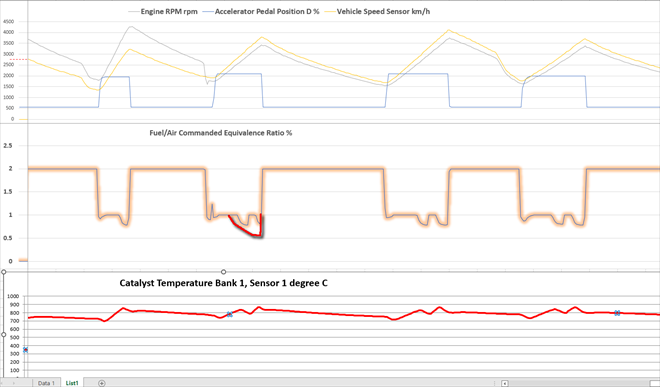
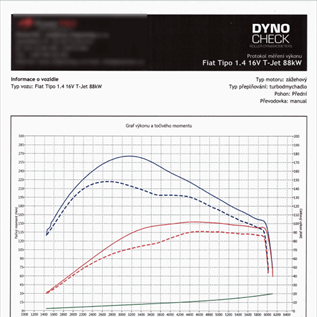
The internet is full of offers of Chiptuning, and those who offer it are doing the exercises in advertising how good they are and how the others are no good. Here at FCD Garage, we occasionally come across software modifications that are often revealed by our initial broad log recorded by the FCD Logger. If the FCD Logger is used, we don't even have to see the car, and just by looking at the data in the graphs, we can recognise that whoever modified the engine data knows very little about engines.
The electronics of today's modern engines are so extensive and interconnected that jerking or setting of a DTC may be caused elsewhere than the fault code message indicates. For example, the EDC 16 engine control unit software is documented on 24 000 A4 pages!
It's therefore virtually impossible for a "chiptuner" to make the modifications to increase the engine power correctly. Minor modification of data in one place can cause unexpected changes in the behaviour of the engine or the complete vehicle in many other places. It's similar to installing a part to a car that isn't designed for that car.
Because they have not encountered any drawbacks of chiptuning, or they are not aware of them (yet), or they are ignoring them. There are many negative impacts resulting from chiptuning. Among the most notable are the exceeded limits of toxic nitrogen oxides, soot, carbon monoxide, and hydrocarbons. In general, only a few people pay attention to these. Other impacts include overloading, both by pressure on the piston and the thermal hazard applied to many engine components that owners who have had their cars "modified" risk. When something fails, they usually say, "But it was worth it!". There are only a few exceptions where chiptuning can be hypothetically defended. E.g. in the case of physically identical vehicles where the manufacturer has deliberately restricted the power of one type (e.g. tax advantages), and they only differ by software.
The golden years of Chiptuning are over, and that's because the feedback software used on cars twenty years ago is not implemented anymore. The current cars on the road use simulated model maps, where feedback only has a monitoring or diagnostic role, not a controlling role. This is why the modified data applied to the control unit often turn on the MIL light and are the cause of why DTC's are stored in memory.
In our example, there are several errors. For example, increasing the turbocharger's boost pressure with spark-ignition engines is impossible because we will soon reach the limit where the mixture starts to detonate due to the high pressure. This limit can be to a certain point extended by cooling the mixture with extra fuel, which, due to the lack of oxygen, doesn't burn entirely and, therefore, considerably impairs the emissions and consumption.
In our case, everything that could be violated was violated. Although the pre-ignition control moved the ignition to 10° ATDC, the vehicle diagnostics didn't report any fault. A fault should have been reported. This is because "chiptuners" very often, as desperate steps, deactivate DTC codes and MIL light activation where they interfere with their intended modification. It is then difficult to detect faults on such vehicles because the fault memory remains empty, despite that the engine could be running in Limp-home mode. Here, in our case, the control unit only reports the consequences and not the cause. The log recording revealed the cause.
The result is that this "Chiptuning" is a mistake that will destroy engines without the ability to identify their "source". The engine power increase will be minimal if any.
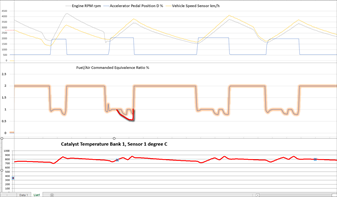
The mixture enrichment represented by the hand-drawn red line would be a typical curve for mixture enrichment to eliminate engine "knock". With the richer mixture, the pre-ignition would be in the positive values, heat loss would be lower, and the engine would have higher efficiency and power. The exhaust and catalytic converter wouldn't heat up so much.
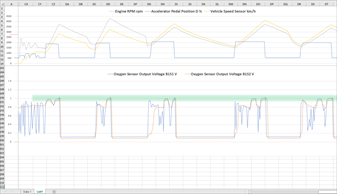
The green area indicates where the Lambda sensor's voltage shouldn't move from during the full load period. However, the recording shows that the voltage is approaching turning point voltage values (voltage jump of the "jump" or two-point Lambda sensor). As a result, the mixture cannot cool, and the temperature rises.

Green (boost pressure) shows an unusually high value. The high pressure and high temperature due to the lean mixture impact the consequences. The pre-ignition values have moved below the dashed line (where they usually shouldn't go) to –10° ATDC. The result is overheating of the exhaust and catalytic converter, and worse, it doesn't increase the engine power. On the contrary.
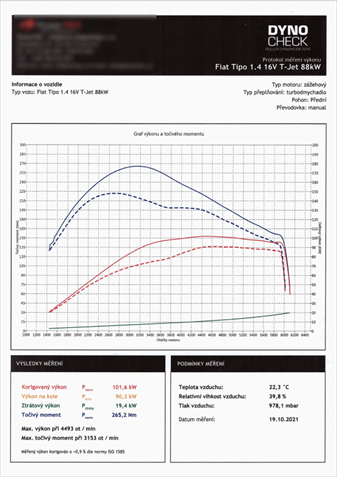
The chiptuners very often show higher power and torque values over the standard achieved by their modified data. This is, unfortunately, only about 30% of the information that the customer knows about how his engine and powertrain are going to be punished or not. This power gain trace is what sells. If the modification had been done correctly without the lean condition, the power increase would have been even higher.
Kompletní informace na toto téma
a mnoho dalších informací najdete pod odkazy níže.
Vyzkoušejte si nás nezávazně na 14 dní zdarma.
Vyzkoušet 14 dní zdarma
Komentáře (0)
Vložit soubor